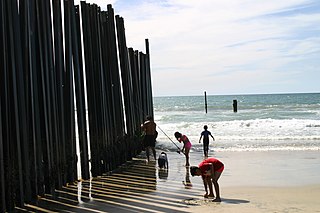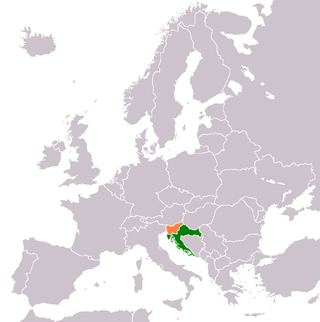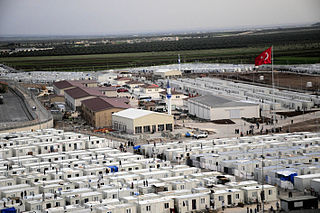Illegal immigration is the migration of people into a country in violation of that country's immigration laws, or the continuous residence in a country without the legal right to. Illegal immigration tends to be financially upward, from poorer to richer countries. Illegal residence in another country creates the risk of detention, deportation, and/or other sanctions.

Illegal entry is the act of foreign nationals arriving in or crossing the borders into a country in violation of its immigration law. Human smuggling is the practice of aiding people in crossing international borders for financial gain, often in large groups. Human smuggling is associated with human trafficking. A human smuggler will facilitate illegal entry into a country for a fee, but on arrival at their destination, the smuggled person is usually free. Trafficking involves physical force, fraud, or deception to obtain and transport people, usually for enslavement or forced prostitution.
Refugees of the Syrian Civil War are citizens and permanent residents of Syria who have fled the country throughout the Syrian Civil War. The pre-war population of the Syrian Arab Republic was estimated at 22 million (2017), including permanent residents. Of that number, the United Nations (UN) identified 13.5 million (2016) as displaced persons, requiring humanitarian assistance. Of these, since the start of the Syrian Civil War in 2011 more than six million (2016) were internally displaced, and around five million (2016) had crossed into other countries, seeking asylum or placed in Syrian refugee camps worldwide. It is often described as one of the largest refugee crises in history.

A border barrier, border fence or border wall is a separation barrier that runs along or near an international border. Such barriers are typically constructed for border control purposes such as curbing illegal immigration, human trafficking, and smuggling. Some such barriers are constructed for defence or security reasons. In cases of a disputed or unclear border, erecting a barrier can serve as a de facto unilateral consolidation of a territorial claim that can supersede formal delimitation. A border barrier does not usually indicate the location of the actual border, and is usually constructed unilaterally by a country, without the agreement or cooperation of the other country.

During 2015, there was a period of significantly increased movement of refugees and migrants into Europe. 1.3 million people came to the continent to request asylum, the most in a single year since World War II. They were mostly Syrians, but also included significant numbers from Afghanistan, Nigeria, Pakistan, Iraq, Eritrea, and the Balkans. The increase in asylum seekers has been attributed to factors such as the escalation of various wars in the Middle East and ISIL's territorial and military dominance in the region, as well as Lebanon, Jordan, and Egypt ceasing to accept Syrian asylum seekers.

The Calais Jungle was a refugee and immigrant encampment in the vicinity of Calais, France that existed from January 2015 to October 2016. There had been other camps known as "jungles" in previous years, but this particular shanty town drew global media attention during the peak of the European migrant crisis in 2015, when its population grew rapidly. Migrants stayed at the camp while they attempted to enter the United Kingdom, or while they waited for their French asylum claims to be processed.

Migrants have gathered in and around Calais, on the northern French coast, since at least the late 1990s seeking to enter the United Kingdom from the French port by crossing the Channel Tunnel or stowing away in the cargo area of lorries heading for ferries that cross the English Channel. During this time, informal camps of migrants have formed, the most notorious commonly referred to as the Calais Jungle. Other migrants come to the area because they are homeless while seeking asylum in France. The presence of migrants in and around Calais has affected the British and French governments, the Eurotunnel and P&O Ferries companies, and lorry drivers heading for the UK and their companies. EuroTunnel, the company that operates the Channel Tunnel, said that it intercepted more than 37,000 migrants between January and July 2015.

In 2015, Hungary built a border barrier on its border with Serbia and Croatia. The fence was constructed during the European migrant crisis, with the aim to ensure border security by preventing illegal immigrants from entering, and enabling the option to enter through official checkpoints and claim asylum in Hungary in accordance with international and European law. The number of illegal entries to Hungary declined greatly after the barrier was finished as it effectively abolished the entry to Hungary.

The Slovenian border barrier was a border barrier constructed by Slovenia in 2015–2016 on its border with Croatia as a response to the European migrant crisis. Both Slovenia and Croatia are European Union members, therefore the barrier was located on an internal EU border; but previously only Slovenia was a member of the free travel Schengen Area, with Croatia joining the area in 2023. In March 2016, Slovenia announced that only migrants who apply for asylum in Slovenia and those with clear humanitarian needs will be allowed to enter Slovenian territory.
Austrian border barriers are border barriers and migration management facilities constructed by Austria between November 2015 and January 2016 on its border with Slovenia and in 2016 on its border with Italy, as a response to European migrant crisis. They are located on internal European Union borders, since Austria, Italy, and Slovenia are members of the EU and the free travel Schengen Area with a common visa policy. The barrier on the Slovenian border is several kilometres long, located near the busiest border crossing, Spielfeld-Šentilj, and includes police facilities for screening and processing migrants. Another migration management facility with barriers located on Austria's Italian border near Brenner, South Tyrol was constructed in 2016.

The Bulgaria–Turkey border is a 513 km (319 mi) long international border between the Republic of Bulgaria and the Republic of Turkey. It was established by the Treaty of San Stefano in 1878 as an inner border within the Ottoman Empire between Adrianople Vilayet and the autonomous province of Eastern Rumelia. The current borders are defined by the Treaty of Constantinople (1913) and the Bulgarian–Ottoman convention (1915). The border was reaffirmed by the Treaty of Lausanne ten years later, though Bulgaria was not a party to the latter treaty as it had earlier ceded to Greece that part of its border with Turkey which was modified by the Bulgarian-Ottoman convention.

This is a timeline of the European migrant crisis of 2015 and 2016.
The Norway–Russia border barrier is an international border barrier built by Norway on the Norway–Russia border. Construction of the barrier began in September 2016 and took a few months. The intent of the project was to prevent the smuggling and illegal crossing of migrants from the Middle East, mainly from Syria, who have used Russia as a route of entry into Norway.
Refugees in Poland were, until 2022, a relatively small group. Since 1989, the number of people applying for refugee status in Poland has risen from about 1,000 to 10,000 each year; about 1–2% of the applications were approved. The majority of applications were citizens of the former Soviet Union.

The Greece–Turkey border is around 200 kilometres (120 mi) long, and separates Western Thrace in Greece from East Thrace in Turkey.

Turkey's migrant crisis, sometimes referred to as Turkey's refugee crisis, was a period during the 2010s characterised by a high number of people migrating to Turkey. Turkey received the highest number of registered refugees of any country or territory each year from 2014 to 2019, and had the world's largest refugee population according to the United Nations High Commissioner for Refugees (UNHCR). The majority were refugees of the Syrian Civil War, numbering 3.6 million as of June 2020. In 2018, the UNHCR reported that Turkey hosted 63.4% of all "registered Syrian refugees."
The migration and asylum policy of the European Union is within the area of freedom, security and justice, established to develop and harmonise principles and measures used by member countries of the European Union to regulate migration processes and to manage issues concerning asylum and refugee status in the European Union.
Pushback is a term that refers to "a set of state measures by which refugees and migrants are forced back over a border – generally immediately after they crossed it – without consideration of their individual circumstances and without any possibility to apply for asylum". Pushbacks violate the prohibition of collective expulsion of aliens in Protocol 4 of the European Convention on Human Rights and often violate the international law prohibition on non-refoulement.
The European Union response to the 2015 migrant crisis focused on how the countries organized the efforts in response to the 2015 European migrant crisis at the EU level. The European Commission in May 2015 proposed distributing the incoming refugees based on GDP and population. This proposal was divisive with Slovakia, Hungary, Romania and the Czech Republic refusing any refugees. Some nation states then called on the EU to reduce funding for member countries who did not want to share burdens and didn't share "values...need to start asking themselves questions about their place in the European Union". This attempt to coalition build failed, the European Commission proceeded to strengthen existing systems such as the Common European Asylum System (CEAS), reforming the Dublin Regulation and centralizing the asylum process. There was also challenges to the European borders which came from the Mediterranean Sea; as a response the European Border and Coast Guard Agency engaged in a new operation called Operation Triton.











